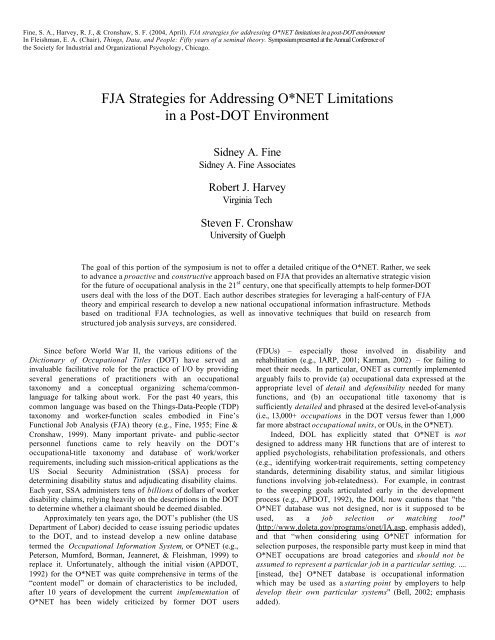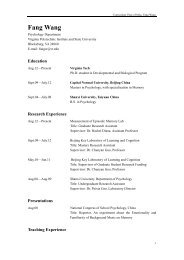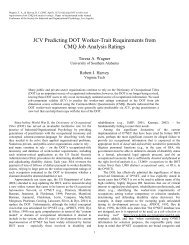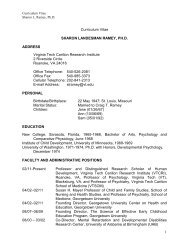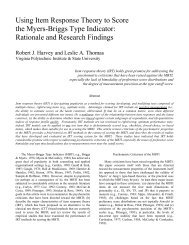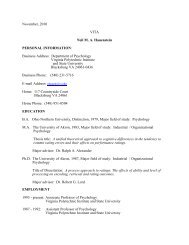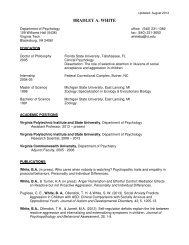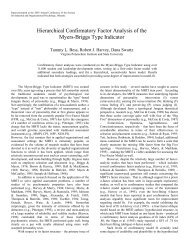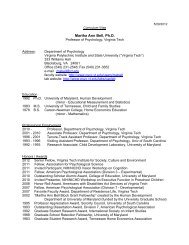FJA Strategies for Addressing O*NET Limitations in a Post-DOT ...
FJA Strategies for Addressing O*NET Limitations in a Post-DOT ...
FJA Strategies for Addressing O*NET Limitations in a Post-DOT ...
You also want an ePaper? Increase the reach of your titles
YUMPU automatically turns print PDFs into web optimized ePapers that Google loves.
F<strong>in</strong>e, S. A., Harvey, R. J., & Cronshaw, S. F. (2004, April). <strong>FJA</strong> strategies <strong>for</strong> address<strong>in</strong>g <strong>O*NET</strong> limitations <strong>in</strong> a post-<strong>DOT</strong> environmentIn Fleishman, E. A. (Chair), Th<strong>in</strong>gs, Data, and People: Fifty years of a sem<strong>in</strong>al theory. Symposium presented at the Annual Conference ofthe Society <strong>for</strong> Industrial and Organizational Psychology, Chicago.<strong>FJA</strong> <strong>Strategies</strong> <strong>for</strong> <strong>Address<strong>in</strong>g</strong> <strong>O*NET</strong> <strong>Limitations</strong><strong>in</strong> a <strong>Post</strong>-<strong>DOT</strong> EnvironmentSidney A. F<strong>in</strong>eSidney A. F<strong>in</strong>e AssociatesRobert J. HarveyVirg<strong>in</strong>ia TechSteven F. CronshawUniversity of GuelphThe goal of this portion of the symposium is not to offer a detailed critique of the <strong>O*NET</strong>. Rather, we seekto advance a proactive and constructive approach based on <strong>FJA</strong> that provides an alternative strategic vision<strong>for</strong> the future of occupational analysis <strong>in</strong> the 21 st century, one that specifically attempts to help <strong>for</strong>mer-<strong>DOT</strong>users deal with the loss of the <strong>DOT</strong>. Each author describes strategies <strong>for</strong> leverag<strong>in</strong>g a half-century of <strong>FJA</strong>theory and empirical research to develop a new national occupational <strong>in</strong><strong>for</strong>mation <strong>in</strong>frastructure. Methodsbased on traditional <strong>FJA</strong> technologies, as well as <strong>in</strong>novative techniques that build on research fromstructured job analysis surveys, are considered.S<strong>in</strong>ce be<strong>for</strong>e World War II, the various editions of theDictionary of Occupational Titles (<strong>DOT</strong>) have served an<strong>in</strong>valuable facilitative role <strong>for</strong> the practice of I/O by provid<strong>in</strong>gseveral generations of practitioners with an occupationaltaxonomy and a conceptual organiz<strong>in</strong>g schema/commonlanguage<strong>for</strong> talk<strong>in</strong>g about work. For the past 40 years, thiscommon language was based on the Th<strong>in</strong>gs-Data-People (TDP)taxonomy and worker-function scales embodied <strong>in</strong> F<strong>in</strong>e’sFunctional Job Analysis (<strong>FJA</strong>) theory (e.g., F<strong>in</strong>e, 1955; F<strong>in</strong>e &Cronshaw, 1999). Many important private- and public-sectorpersonnel functions came to rely heavily on the <strong>DOT</strong>’soccupational-title taxonomy and database of work/workerrequirements, <strong>in</strong>clud<strong>in</strong>g such mission-critical applications as theUS Social Security Adm<strong>in</strong>istration (SSA) process <strong>for</strong>determ<strong>in</strong><strong>in</strong>g disability status and adjudicat<strong>in</strong>g disability claims.Each year, SSA adm<strong>in</strong>isters tens of billions of dollars of workerdisability claims, rely<strong>in</strong>g heavily on the descriptions <strong>in</strong> the <strong>DOT</strong>to determ<strong>in</strong>e whether a claimant should be deemed disabled.Approximately ten years ago, the <strong>DOT</strong>’s publisher (the USDepartment of Labor) decided to cease issu<strong>in</strong>g periodic updatesto the <strong>DOT</strong>, and to <strong>in</strong>stead develop a new onl<strong>in</strong>e databasetermed the Occupational In<strong>for</strong>mation System, or <strong>O*NET</strong> (e.g.,Peterson, Mum<strong>for</strong>d, Borman, Jeanneret, & Fleishman, 1999) toreplace it. Un<strong>for</strong>tunately, although the <strong>in</strong>itial vision (AP<strong>DOT</strong>,1992) <strong>for</strong> the <strong>O*NET</strong> was quite comprehensive <strong>in</strong> terms of the“content model” or doma<strong>in</strong> of characteristics to be <strong>in</strong>cluded,after 10 years of development the current implementation of<strong>O*NET</strong> has been widely criticized by <strong>for</strong>mer <strong>DOT</strong> users(FDUs) – especially those <strong>in</strong>volved <strong>in</strong> disability andrehabilitation (e.g., IARP, 2001; Karman, 2002) – <strong>for</strong> fail<strong>in</strong>g tomeet their needs. In particular, ONET as currently implementedarguably fails to provide (a) occupational data expressed at theappropriate level of detail and defensibility needed <strong>for</strong> manyfunctions, and (b) an occupational title taxonomy that issufficiently detailed and phrased at the desired level-of-analysis(i.e., 13,000+ occupations <strong>in</strong> the <strong>DOT</strong> versus fewer than 1,000far more abstract occupational units, or OUs, <strong>in</strong> the <strong>O*NET</strong>).Indeed, DOL has explicitly stated that <strong>O*NET</strong> is notdesigned to address many HR functions that are of <strong>in</strong>terest toapplied psychologists, rehabilitation professionals, and others(e.g., identify<strong>in</strong>g worker-trait requirements, sett<strong>in</strong>g competencystandards, determ<strong>in</strong><strong>in</strong>g disability status, and similar litigiousfunctions <strong>in</strong>volv<strong>in</strong>g job-relatedness). For example, <strong>in</strong> contrastto the sweep<strong>in</strong>g goals articulated early <strong>in</strong> the developmentprocess (e.g., AP<strong>DOT</strong>, 1992), the DOL now cautions that "the<strong>O*NET</strong> database was not designed, nor is it supposed to beused, as a job selection or match<strong>in</strong>g tool"(http://www.doleta.gov/programs/onet/IA.asp, emphasis added),and that “when consider<strong>in</strong>g us<strong>in</strong>g <strong>O*NET</strong> <strong>in</strong><strong>for</strong>mation <strong>for</strong>selection purposes, the responsible party must keep <strong>in</strong> m<strong>in</strong>d that<strong>O*NET</strong> occupations are broad categories and should not beassumed to represent a particular job <strong>in</strong> a particular sett<strong>in</strong>g. ....[<strong>in</strong>stead, the] <strong>O*NET</strong> database is occupational <strong>in</strong><strong>for</strong>mationwhich may be used as a start<strong>in</strong>g po<strong>in</strong>t by employers to helpdevelop their own particular systems" (Bell, 2002; emphasisadded).
<strong>FJA</strong> <strong>Strategies</strong>The above review was <strong>in</strong>cluded not <strong>for</strong> the purpose ofoffer<strong>in</strong>g a detailed critique of the <strong>O*NET</strong>, but rather as a means<strong>for</strong> present<strong>in</strong>g our rationale as to why alternatives to the <strong>O*NET</strong>need to be evaluated. In this presentation, we seek to provide analternative strategic vision <strong>for</strong> the future of job and occupationalanalysis (JOA) <strong>in</strong> the 21 st century, pay<strong>in</strong>g specific attention toaddress<strong>in</strong>g the concerns raised by FDUs <strong>in</strong> the current post-<strong>DOT</strong> environment. In the sections below, each author describesstrategies <strong>for</strong> leverag<strong>in</strong>g a half-century of <strong>FJA</strong> theory andresearch to provide the conceptual foundation <strong>for</strong> develop<strong>in</strong>g anational occupational <strong>in</strong><strong>for</strong>mation <strong>in</strong>frastructure. Although the<strong>O*NET</strong> represents an ambitious undertak<strong>in</strong>g and a substantial<strong>in</strong>vestment of resources (e.g., Peterson et al., 1999), it comprisesonly one of many possible visions <strong>for</strong> the future of JOA. As wedescribe below, we f<strong>in</strong>d numerous advantages <strong>in</strong> tak<strong>in</strong>g anevolutionary approach that builds on the rich theoretical andempirical foundation of <strong>FJA</strong>.Future Research With TDP/<strong>FJA</strong>F<strong>in</strong>e’s <strong>Strategies</strong>The research that produced the Theory of TDP/<strong>FJA</strong> wasundertaken <strong>for</strong> the practical employment objectives of theUnited States Employment Service (USES). These objectives<strong>in</strong>cluded: select<strong>in</strong>g workers who fulfilled employerspecifications, counsel<strong>in</strong>g <strong>in</strong>experienced entrants to the labor<strong>for</strong>ce, guid<strong>in</strong>g workers with handicaps <strong>in</strong>to jobs that suitedthem, and design<strong>in</strong>g jobs <strong>in</strong> general and new careers <strong>in</strong>particular. All of the objectives were met to one degree oranother.Beyond our ef<strong>for</strong>ts to meet these objectives, <strong>FJA</strong> broadenedunderstand<strong>in</strong>g of jobs. Earlier categorization of jobs as skilled,semi-skilled and unskilled was quite mislead<strong>in</strong>g as far as workerskills were concerned. Similarly <strong>in</strong>adequate was the separationof labor<strong>in</strong>g from professional and technical jobs s<strong>in</strong>ce the samefunctions could occur <strong>in</strong> jobs <strong>in</strong> all fields of work. Us<strong>in</strong>g the<strong>FJA</strong> job analysis technique, all work could now be understoodas vary<strong>in</strong>g comb<strong>in</strong>ations of <strong>in</strong>teract<strong>in</strong>g Th<strong>in</strong>gs, Data, and Peoplefunctions on different levels and <strong>in</strong> vary<strong>in</strong>g comb<strong>in</strong>ations.Although some jobs might be on a low level <strong>in</strong> Th<strong>in</strong>gs or PeopleFunctions, they could be on a high level <strong>in</strong> Data and vice versa.There was now one language to describe all work.From a selection standpo<strong>in</strong>t it was clear that traits such asstrength, <strong>in</strong>telligence and education were possibly less importantthan Adaptive Skills, the skills required to manage oneself <strong>in</strong>relation to con<strong>for</strong>mity and change. Many Adaptive Skills haverecently been referred to under the rubric of emotional<strong>in</strong>telligence. Included <strong>in</strong> these skills are adaptations to theenvironment of work; mov<strong>in</strong>g toward, away from, or aga<strong>in</strong>stpeople; and especially the universal requirement of adapt<strong>in</strong>g to<strong>in</strong>structions that range from prescriptive to discretionary — hereaga<strong>in</strong> <strong>in</strong> vary<strong>in</strong>g comb<strong>in</strong>ations. Clearly jobs requir<strong>in</strong>g lowlevels of Specific Content Skills required significant AdaptiveSkills, which had been more or less taken <strong>for</strong> granted <strong>in</strong> earlierjob descriptions. With the understand<strong>in</strong>g provided by <strong>FJA</strong>,tak<strong>in</strong>g these skills <strong>for</strong> granted was no longer acceptable.Dr.Cronshaw has developed a structured <strong>in</strong>terview thatgenerates <strong>in</strong><strong>for</strong>mation relevant <strong>for</strong> functional selection. The roleof Adaptive Skills is an area of research that needs far more2<strong>in</strong>vestigation. In a study carried out <strong>in</strong> a division of a largeAmerican corporation, Functional Job Analysis helped achievenew <strong>in</strong>sights <strong>in</strong>to the competency requirements of eng<strong>in</strong>eer<strong>in</strong>gpersonnel, particularly service eng<strong>in</strong>eers. Adaptive Skills turnedout to be at least as essential as Functional and Specific ContentSkills.In the area of selection, functional job analysis provides aneffective basis <strong>for</strong> synthetic validity. In my dissertation (1962),I was able to predict specific aptitude patterns <strong>for</strong> selected jobsequally as well as the empirical studies done with the GeneralAptitude Battery thus demonstrat<strong>in</strong>g that functional job analysiscould be used as a criterion <strong>for</strong> the empirical determ<strong>in</strong>ation ofspecific aptitude pattern, a f<strong>in</strong>d<strong>in</strong>g that could have far reach<strong>in</strong>gimplications. I have made an item-by-item comparison of thefunctional skills of <strong>FJA</strong> and the General Work Activities(GWA) described <strong>in</strong> <strong>O*NET</strong>. They are remarkably similar,some of them hav<strong>in</strong>g almost identical phrases despite the factthat there is at least a 20-year time span between them. It wouldseem that just as Th<strong>in</strong>gs, Data, and People are underly<strong>in</strong>gfactors <strong>in</strong> the job spectrum, general work activities or workerorientedvariables are likewise basic <strong>in</strong> the world of work. Thisshould be a fruitful area <strong>for</strong> research to establish whether thesevariables are truly universal and there<strong>for</strong>e useful as build<strong>in</strong>gblocks <strong>in</strong> selection and job design.One especially attractive aspect of <strong>FJA</strong> is that it is possibleto deconstruct jobs <strong>in</strong>to their various functions and relatespecific tra<strong>in</strong><strong>in</strong>g components to these functions. About 40 yearsago, I was urged by two New York University professors todevelop guidel<strong>in</strong>es <strong>for</strong> the design of new careers <strong>for</strong> entrants<strong>in</strong>to the labor <strong>for</strong>ce. I outl<strong>in</strong>ed a technique <strong>for</strong> do<strong>in</strong>g so <strong>in</strong> awidely circulated brochure entitled, “Guidel<strong>in</strong>es <strong>for</strong> the Designof New Careers,” thereby mak<strong>in</strong>g the technique available tosocial service agencies throughout the country. I applied thetechnique <strong>in</strong> a demonstration project <strong>for</strong> the state of Utah,show<strong>in</strong>g that the lower-level functions of social worker jobs,those <strong>in</strong>volv<strong>in</strong>g limited specific content, could be <strong>in</strong>corporated<strong>in</strong>to jobs <strong>for</strong> persons on welfare. Quite a few <strong>in</strong>dividuals werehired <strong>for</strong> these jobs. After ga<strong>in</strong><strong>in</strong>g experience, a few returned toschool to study and become social workers. This design aspectof <strong>FJA</strong> is als o <strong>in</strong> need of further research.<strong>FJA</strong> posits a certa<strong>in</strong> balanced humaneness <strong>in</strong> the functionalload<strong>in</strong>g of jobs. Early <strong>in</strong> our job analysis studies we discoveredhow jobs were unbalanced by be<strong>in</strong>g under- or overloaded withfunctional requirements and <strong>in</strong>structions. These requirements<strong>in</strong>terfered with productivity and were unreasonable <strong>for</strong>achiev<strong>in</strong>g the standards of both workers and employers. <strong>FJA</strong>made this quite evident. In today’s work world where there isso much fluidity, downsiz<strong>in</strong>g and reorganiz<strong>in</strong>g, it would beespecially useful to apply <strong>FJA</strong> to research with the objective ofm<strong>in</strong>imiz<strong>in</strong>g the chaos that is reported to occur.One of the outstand<strong>in</strong>g applications of TDP/<strong>FJA</strong> can befound <strong>in</strong> the USES publication entitled: “Guide <strong>for</strong>Occupational Exploration” (1979). This guide was widely used,and as far as I know, is still be<strong>in</strong>g used, as a counsel<strong>in</strong>g tool. Itpurports to describe work situations draw<strong>in</strong>g not only onfunctional concepts but also on the extensive trait research thatwas carried out at the same time as the development ofTDP/<strong>FJA</strong>. The traits drawn upon appeared <strong>in</strong> the publication,“Estimates of Worker Trait Requirements <strong>for</strong> 4,000 JobsDef<strong>in</strong>ed <strong>in</strong> the Dictionary of Occupational Titles,” published <strong>in</strong>
<strong>FJA</strong> <strong>Strategies</strong>1956. The “Guide <strong>for</strong> Occupational Exploration” wasextensively used by the Social Security Adm<strong>in</strong>istration to makedecisions associated with workers apply<strong>in</strong>g <strong>for</strong> disability due toillness or accident and to determ<strong>in</strong>e what other jobs they mightper<strong>for</strong>m with their residual Functional and Adaptive Skills. Themost famous vocational self-help book <strong>in</strong> the world, What Coloris Your Parachute? by Richard Bolles also makes effective useof TDP/<strong>FJA</strong> theory <strong>in</strong> guid<strong>in</strong>g readers <strong>in</strong> their self-exploration.to arrive at a vocational choice.What Works, What Doesn’t?Harvey’s <strong>Strategies</strong>When chart<strong>in</strong>g a course <strong>for</strong> the future of JOA <strong>in</strong> a post-<strong>DOT</strong> environment, an obvious place to start would be to askourselves two questions: (a) what did the <strong>DOT</strong> do right <strong>in</strong> termsof provid<strong>in</strong>g a useful national database of occupational<strong>in</strong><strong>for</strong>mation (i.e., aspects that we should ma<strong>in</strong>ta<strong>in</strong> <strong>in</strong> successorsystems); and (b) what did the <strong>DOT</strong> do wrong that we should tryto avoid? Although change is necessary and useful, progress <strong>in</strong>science and technology is usually enhanced to the degree thatwe attempt to build upon past theoretical and empiricalaccomplishments, and avoid perpetuat<strong>in</strong>g past mistakes; <strong>in</strong> myview, when develop<strong>in</strong>g a successor to the <strong>DOT</strong>, the field of JOAwould do well to follow such a plan.Although the <strong>DOT</strong> was widely used <strong>for</strong> over a half-century,some limitations were present (e.g., see Ca<strong>in</strong> & Green, 1983;Bol<strong>in</strong>g & F<strong>in</strong>e, 1959; Harvey, 1992; Webb, Shavelson, Shea, &Morello, 1981), particularly regard<strong>in</strong>g the psychometric andlegal-defensibility status of the practice of us<strong>in</strong>g s<strong>in</strong>gle-itemscales to holistically rate abstract worker-trait requirements. Tomy read<strong>in</strong>g of the literature, the above <strong>DOT</strong>-focused studies, aswell as those that exam<strong>in</strong>ed holistic rat<strong>in</strong>gs <strong>in</strong> other JOArelevantsett<strong>in</strong>gs (e.g., Butler & Harvey, 1988; DeNisi & Shaw,1977; Gibson, Harvey, & Qu<strong>in</strong>tela, 2004; Harvey & Hollander,2002; Harvey, Wilson, & Blunt, 1994), argue <strong>for</strong>cefully aga<strong>in</strong>stthe use of holistic scales <strong>in</strong> the <strong>DOT</strong>’s successor.Additional research is needed to fully document the rangeof situations <strong>in</strong> which holistic judgments fail to convergeadequately with data collected us<strong>in</strong>g traditional (and defensible)decomposed-judgment strategies; however, past research hasalready documented a range of cases <strong>in</strong> which low holisticdecomposedconvergent validity was seen <strong>for</strong> rat<strong>in</strong>gs of workertraitrequirements and work-activity constructs. Regard<strong>in</strong>g otherpsychometric issues, ample research already exists to justify theconclusion that holistic rat<strong>in</strong>gs often suffer from poor <strong>in</strong>terrateragreement and low discrim<strong>in</strong>ant validity; <strong>in</strong>deed, some of themost clear-cut and disturb<strong>in</strong>g studies of this type have beenconducted us<strong>in</strong>g large samples of rat<strong>in</strong>gs collected with theactual <strong>O*NET</strong> rat<strong>in</strong>g scales, and the actual raters who providedthe <strong>O*NET</strong> database (e.g., Gibson et al., 2004; Harvey &Hollander, 2002, 2004).Such results should give pause, especially <strong>for</strong> situations <strong>in</strong>which rat<strong>in</strong>gs are to be used <strong>for</strong> litigation-prone functions suchas disability determ<strong>in</strong>ation or employee placement. Althoughthe researchers who developed and revised the <strong>DOT</strong> obviouslydid not have the benefit of be<strong>in</strong>g aware of all of the researchf<strong>in</strong>d<strong>in</strong>gs document<strong>in</strong>g the poor per<strong>for</strong>mance of holistic rat<strong>in</strong>gsthat have emerged over the past 25 years, such results must be3considered as the field of JOA goes about the ongo<strong>in</strong>g processof develop<strong>in</strong>g replacements <strong>for</strong> the <strong>DOT</strong> that will take usthrough the 21 st century of occupational analysis.Although holistic rat<strong>in</strong>gs constitute an aspect of the <strong>DOT</strong>’sdesign that – <strong>in</strong> my view – should not be perpetuated, manyaspects of the <strong>DOT</strong>’s vision <strong>for</strong> occupational analysis werehighly successful, and should be built-upon by its successor,<strong>in</strong>clud<strong>in</strong>g: (a) us<strong>in</strong>g an occupational-title taxonomy that strikes abalance between the conflict<strong>in</strong>g goals of parsimony versusgranularity; (b) rely<strong>in</strong>g on skilled occupational analysts tocollect rat<strong>in</strong>gs to enhance confidence <strong>in</strong> data quality; (c)provid<strong>in</strong>g task-level descriptions <strong>in</strong> addition to more macroviews; and (d) offer<strong>in</strong>g a conceptual foundation built on <strong>FJA</strong>’sTDP taxonomy to provide a high-level common language withwhich to describe general work activities (GWAs) and compareoccupations. The perceived absence of these characteristics <strong>in</strong><strong>O*NET</strong> <strong>for</strong>ms a common theme among criticisms raised byFDUs (e.g., IARP, 2001; Karman, 2002).How to Move Forward?Return<strong>in</strong>g to the focus of this presentation, what <strong>for</strong>wardlook<strong>in</strong>gsolutions do I offer to address the problems ofdevelop<strong>in</strong>g a suitable replacement <strong>for</strong> the <strong>DOT</strong> and mollify<strong>in</strong>gdispleased FDUs? Simple: develop an onl<strong>in</strong>e system that (a)builds upon the strengths noted above that were present <strong>in</strong> the<strong>DOT</strong> (particularly, with respect to occupational title granularity,rely<strong>in</strong>g on expert raters, rat<strong>in</strong>g verifiable aspects of work, us<strong>in</strong>gTDP to provide a high-level view of work, and us<strong>in</strong>g <strong>FJA</strong>’sworker-function approach to describe work), and (b) avoids themore significant flaws <strong>in</strong> <strong>DOT</strong> (particularly, holistic rat<strong>in</strong>gs, theabsence of a comprehensive profile of moderate specificityGWAs to supplement TDP, and the <strong>in</strong>frequent schedule onwhich updates to the database were made).Given the ambitious nature of the above objectives, the firstth<strong>in</strong>g I wish to stress is that I am not opposed to the oft-repeatedgoal (e.g., Peterson et al., 2001) of reduc<strong>in</strong>g the costs associatedwith collect<strong>in</strong>g and ma<strong>in</strong>ta<strong>in</strong><strong>in</strong>g a nationwide database ofoccupational <strong>in</strong><strong>for</strong>mation. However, the truism that “there is nofree lunch” is, <strong>in</strong> my view, directly relevant to the task ofreplac<strong>in</strong>g the <strong>DOT</strong>. In short, if users of the <strong>in</strong><strong>for</strong>mationconta<strong>in</strong>ed <strong>in</strong> a national database of JOA <strong>in</strong><strong>for</strong>mation lackadequate confidence regard<strong>in</strong>g its accuracy, psychometricquality, relevance, comprehensibility, or legal defensibility, itarguably does not matter how much money was saved whencollect<strong>in</strong>g or updat<strong>in</strong>g it. “Job One” with respect to develop<strong>in</strong>g aworthy replacement <strong>for</strong> the <strong>DOT</strong>, <strong>in</strong> my assessment, is to beable to provide the most accurate, comprehensive, useful,defensible, and accessible database possible. Althoughconta<strong>in</strong><strong>in</strong>g costs is important, if the primary objective is notachieved, the result<strong>in</strong>g database arguably lacks value even if itcost noth<strong>in</strong>g to collect.For example, consider the SSA, an organization thatcont<strong>in</strong>ues to rely heavily on <strong>DOT</strong>-centric descriptions of workto defend its determ<strong>in</strong>ations regard<strong>in</strong>g worker disability status <strong>in</strong>court. For SSA, a change of only a few percentage po<strong>in</strong>ts withrespect to the ratio of disability-status cases that it w<strong>in</strong>s versusloses <strong>in</strong> court could translate <strong>in</strong>to billions of dollars of yearlybottom-l<strong>in</strong>e impact. With stakes of this magnitude, even thecosts associated with ma<strong>in</strong>ta<strong>in</strong><strong>in</strong>g the pr<strong>in</strong>t-based <strong>DOT</strong> look like
<strong>FJA</strong> <strong>Strategies</strong>a barga<strong>in</strong>; given the significant advances <strong>in</strong> technology (seebelow) that have occurred s<strong>in</strong>ce the last major revision of the<strong>DOT</strong>, it is likely that significant efficiencies can be achievedwith respect to that cost basel<strong>in</strong>e.F<strong>in</strong>ally, with respect to the goal of identify<strong>in</strong>g strategies <strong>for</strong>advanc<strong>in</strong>g JOA <strong>in</strong> a post-<strong>DOT</strong> world, I’ll conclude by offer<strong>in</strong>gtwo arguments that some may f<strong>in</strong>d surpris<strong>in</strong>g. First, the “workeroriented” standardized “xxQ” job surveys that have achievedsuch popularity (e.g., see Harvey, 1991a; McCormick,Jeanneret, & Mecham, 1972) have all – to vary<strong>in</strong>g degrees –failed to achieve their stated objective. Second, the demise of<strong>DOT</strong> and the limitations of <strong>O*NET</strong> do not constitute“problems” fac<strong>in</strong>g our field; rather, they offer uniqueopportunities and stimulus <strong>for</strong> JOA researchers to make majortechnological advancements.What is “Worker-Oriented” Job Analysis?For many years I have struggled (e.g., Harvey, 1991a, pp.94-99) with the task of conceptually differentiat<strong>in</strong>g between socalled“worker-oriented” methods of JOA versus task- or“work-oriented” ones. That is, although many authors (e.g.,McCormick, 1976; McCormick et al., 1972) have had noapparent difficulty <strong>in</strong> draw<strong>in</strong>g fundamental qualitativedist<strong>in</strong>ctions between task-<strong>in</strong>ventory methods versus structuredsurveys like the PAQ, from my perspective the ma<strong>in</strong> differencebetween CODAP-style task <strong>in</strong>ventories versus structuredsurveys like the PAQ is not primarily a qualitative one at all.Rather, the dist<strong>in</strong>ction is primarily one of degree, with taskorientedmethods rat<strong>in</strong>g items that fall toward the higher end ofthe behavioral-technological specificity cont<strong>in</strong>uum, and socalledworker-oriented methods rat<strong>in</strong>g items that def<strong>in</strong>e moremoderate-specificity aspects of work (see Figure 1).Interest<strong>in</strong>gly, <strong>in</strong> both cases work activities are rated us<strong>in</strong>gsimilar – if not identical – scales (e.g., Frequency, Importance,Time Spent), and substantial similarity is often present betweenthe items <strong>in</strong> “worker-oriented” surveys versus task <strong>in</strong>ventories(especially ones designed to apply to a number of differentjobs), to the po<strong>in</strong>t that <strong>in</strong> a bl<strong>in</strong>d-judgment task it is oftendifficult to retranslate items back <strong>in</strong>to their <strong>in</strong>tended “work-”versus “worker-oriented” categories. Although an obviousdifference exists with respect to the fact that standardizedsurveys are typically used off-the-shelf (versus task <strong>in</strong>ventoriesbe<strong>in</strong>g customized to each situation), <strong>in</strong> terms of the basicprocess of how they analyze jobs I have been at a loss to expla<strong>in</strong>how these supposedly different “philosophies” of job analysis(e.g., Cornelius, Carron, & Coll<strong>in</strong>s, 1979) differed qualitatively.After conduct<strong>in</strong>g a dialog with Sidney F<strong>in</strong>e over the pastcouple of years, I’m now <strong>in</strong>cl<strong>in</strong>ed to th<strong>in</strong>k – as with many th<strong>in</strong>gs– that with respect to the issue of what “worker-oriented” jobanalysis really means, Sid had it right all along, and that he “gotit” way be<strong>for</strong>e anybody else. Specifically, I’m argu<strong>in</strong>g that (a)<strong>FJA</strong> deserves the title of “first worker-oriented job analysismethod,” and (b) later claims that have been made by a range ofstandardized job analysis <strong>in</strong>struments (<strong>in</strong>clud<strong>in</strong>g my structuredjob analysis survey, the CMQ; e.g., Harvey, 1991b) to themantle of be<strong>in</strong>g “worker-oriented” are – to vary<strong>in</strong>g degrees –lack<strong>in</strong>g with respect to fulfill<strong>in</strong>g the goals of this approach asthey were orig<strong>in</strong>ally articulated (e.g., F<strong>in</strong>e, 1955).Although often characterized as be<strong>in</strong>g an example of the4task- or “work” oriented approach (i.e., due to its focus on tasks,as well as the technology of writ<strong>in</strong>g good task statements), oneof the most important conceptual aspects of <strong>FJA</strong> is itspioneer<strong>in</strong>g theoretical statement to the effect that all workactivity must be broken down to its basic functional elements –i.e., the levels of Data, People, and Th<strong>in</strong>gs <strong>in</strong>volved <strong>in</strong>per<strong>for</strong>m<strong>in</strong>g the activity. Accord<strong>in</strong>g to <strong>FJA</strong>, the work- versusworker-oriented philosophy issue reduces to a question ofdifferentiat<strong>in</strong>g between “what gets done” (i.e., work-oriented)versus “what the worker does” (i.e., worker-oriented, or the“functional skills” of <strong>FJA</strong>) to accomplish those activities. Asimilar def<strong>in</strong>ition of the different objectives of work- versusworker-oriented analysis was offered by McCormick (1976).<strong>FJA</strong> achieves the objectives of worker-oriented analysis viaidentify<strong>in</strong>g the tasks that are per<strong>for</strong>med on each job, then scal<strong>in</strong>geach with respect to how it ranks on the TDP functions. Thus,the essential question with respect to determ<strong>in</strong><strong>in</strong>g the degree ofworker-oriented-ness of a given JOA approach is not one ofwhat behaviors are per<strong>for</strong>med or rated on the job (be they low-,moderate-, or high-specificity), but rather one of how thoseactivities are rated and l<strong>in</strong>ked-back to identify their stand<strong>in</strong>gwith respect to the underly<strong>in</strong>g general dimensions of work.Hence, my conclusion that the so-called worker-orientedJOA surveys <strong>in</strong> widespread use today are deficient with respectto achiev<strong>in</strong>g the true worker-oriented goal of describ<strong>in</strong>g workactivities <strong>in</strong> terms of the underly<strong>in</strong>g worker-functions <strong>in</strong>volved<strong>in</strong> per<strong>for</strong>m<strong>in</strong>g them. Two fundamental issues can be identified,given that most exist<strong>in</strong>g “worker-oriented” questionnairesactually comprise a mix of items describ<strong>in</strong>g both work- andworker-oriented content. First, <strong>for</strong> rated items that def<strong>in</strong>e workorientedaspects of work (e.g., PAQ item 52, us<strong>in</strong>g “longhandled tools,” or 74, operat<strong>in</strong>g “air/space vehicles”), the scalesused to rate these activities do not describe the worker-functions<strong>in</strong>volved <strong>in</strong> per<strong>for</strong>m<strong>in</strong>g the work. Second, <strong>for</strong> cases <strong>in</strong> which theitems actually do def<strong>in</strong>e content deal<strong>in</strong>g with required workerfunctions(e.g., PAQ item 42, “cod<strong>in</strong>g/decod<strong>in</strong>g,” or 37,“reason<strong>in</strong>g <strong>in</strong> problem solv<strong>in</strong>g”), (a) the rat<strong>in</strong>g scale is oftendifficult to use or relativistic (see Harvey, 1991a), and (b) therat<strong>in</strong>g task becomes a holistic one <strong>in</strong> which the analyst isrequired to attempt the daunt<strong>in</strong>g task of mak<strong>in</strong>g a s<strong>in</strong>gle-itemrat<strong>in</strong>g that accurately describes the overall level of the workerfunctionrequired to per<strong>for</strong>m the job.Regard<strong>in</strong>g the first issue, JOA surveys that focus on rat<strong>in</strong>gmoderate-specificity work-activity items us<strong>in</strong>g the same types ofscales seen <strong>in</strong> the task-<strong>in</strong>ventory approach (e.g., PAQ, JEI)arguably represent the highest level of departure from thephilosophical goals of worker-oriented job analysis. That is,task-<strong>in</strong>ventory style rat<strong>in</strong>g scales (e.g., Time-Spent, Importance,Criticality) say noth<strong>in</strong>g with respect to directly def<strong>in</strong><strong>in</strong>g thelevels of the underly<strong>in</strong>g worker-functions <strong>in</strong>volved <strong>in</strong>per<strong>for</strong>m<strong>in</strong>g each activity. For example, consider PAQ item 55,which describes the use of “powered nonprecision tools/<strong>in</strong>struments;” it is rated us<strong>in</strong>g a s<strong>in</strong>gle scale to describe how“Important to this job” the activity is (rang<strong>in</strong>g from “Does notapply” to “Extreme”). This judgment task is arguably quitesimilar to the judgments <strong>in</strong>volved <strong>in</strong> rat<strong>in</strong>g similar items <strong>in</strong> thetask <strong>in</strong>ventory method (e.g., us<strong>in</strong>g an Importance scale to ratethe use of tools such as “Weed eater,” “Grass edger,” “Leafblower,” and “Air chisel”).It is certa<strong>in</strong>ly useful to know how often such activities are
<strong>FJA</strong> <strong>Strategies</strong>per<strong>for</strong>med, and to assess their perceived importance to the job asa whole. However, such rat<strong>in</strong>gs do not address the workerorientedgoal of identify<strong>in</strong>g the functions the worker needs touse to accomplish the activity. For example, with respect to thetool-focused items above, it may be critical to know whether (a)workers simply tend or handle such tools versus be<strong>in</strong>g requiredto per<strong>for</strong>m advanced repair and troubleshoot<strong>in</strong>g activities, or (b)workers operate the tool or <strong>in</strong>strument under the closesupervision of someone else versus direct<strong>in</strong>g and evaluat<strong>in</strong>g theuse of the tool or <strong>in</strong>strument by others.Of course, one might attempt to achieve the workerorientedgoal by <strong>in</strong>term<strong>in</strong>gl<strong>in</strong>g worker-function content with thework-oriented descriptions of each activity. For example, onemight <strong>for</strong>m separate items <strong>for</strong> each type of tool used on the job(with an item <strong>for</strong> tend<strong>in</strong>g the tool, handl<strong>in</strong>g the tool, operat<strong>in</strong>gthe tool, start<strong>in</strong>g/stopp<strong>in</strong>g the tool, repair<strong>in</strong>g the tool, sett<strong>in</strong>g-upthe tool, supervis<strong>in</strong>g others us<strong>in</strong>g the tool, tra<strong>in</strong><strong>in</strong>g others to usethe tool, etc.), and then rate each item us<strong>in</strong>g a Time-Spent orImportance scale. However, such an approach is arguably muchless conceptually and adm<strong>in</strong>istratively parsimonious than the<strong>FJA</strong> practice of tak<strong>in</strong>g a matrix approach that clearly separates“row” work-oriented activities from “column” worker-orientedrat<strong>in</strong>gs specify<strong>in</strong>g the TDP functional level required <strong>for</strong> the row.Regard<strong>in</strong>g the second issue, it is important to note that I amnot argu<strong>in</strong>g that <strong>in</strong>struments based on the S-O-R model (e.g.,Jeanneret, Borman, Kubisiak, & Hanson, 1999) lack any itemsdef<strong>in</strong><strong>in</strong>g worker-oriented content. Although <strong>in</strong>struments like thePAQ conta<strong>in</strong> many items that focus on work-oriented <strong>in</strong>puts,outputs, and contextual characteristics, they clearly conta<strong>in</strong>others that focus on the worker-oriented “mediat<strong>in</strong>g processes”that occur between <strong>in</strong>puts, outputs, and context. For example,the PAQ’s Mental Processes section rates characteristics that arehighly similar to the levels of <strong>FJA</strong>’s Data function (e.g.,“compil<strong>in</strong>g,” “cod<strong>in</strong>g/decod<strong>in</strong>g,” “transcrib<strong>in</strong>g,” “analyz<strong>in</strong>g”).Un<strong>for</strong>tunately, such worker-oriented content rat<strong>in</strong>gs fallsquarely <strong>in</strong> the category of holistic judgment. That is, becausethe worker-oriented content is conta<strong>in</strong>ed <strong>in</strong> the rated activity (asopposed to be<strong>in</strong>g described via the rat<strong>in</strong>g scales, as <strong>in</strong> <strong>FJA</strong>),raters must make a s<strong>in</strong>gle-item judgment that describes therequired level of each worker-function (e.g., “analyz<strong>in</strong>g”) <strong>for</strong>the job as a holistic, undifferentiated entity. As was notedearlier, a sizable and grow<strong>in</strong>g literature raises fundamentalquestions regard<strong>in</strong>g the degree to which holistic judgments canproduce rat<strong>in</strong>gs that exhibit acceptable levels of convergentvalidity, discrim<strong>in</strong>ant validity, and <strong>in</strong>terrater agreement.How do we overcome these limitations as we develop JOAmeasurement technologies <strong>for</strong> the post-<strong>DOT</strong> era? My suggestionis that we should return to the theoretical clarity offered by <strong>FJA</strong>,and construct JOA surveys us<strong>in</strong>g a matrix approach that (a)stops the practice of <strong>in</strong>term<strong>in</strong>gl<strong>in</strong>g work- and worker-orientedcontent <strong>in</strong> the rated items of the surveys (i.e., the “row”elements that are rated should def<strong>in</strong>e job activities, not workerfunctions);and (b) rates each work activity us<strong>in</strong>g “column”scales that def<strong>in</strong>e the worker-functions associated with eachactivity. In effect, we should stick with the basic logic that <strong>FJA</strong>has employed <strong>for</strong> over a half-century to achieve its workerorientedobjectives; however, to produce standardized surveysthat will be applicable to all jobs and occupations, we need todef<strong>in</strong>e the rated row elements us<strong>in</strong>g moderate-specificity GWAcontent rather than the molecular tasks typically seen <strong>in</strong> <strong>FJA</strong>.5Although I <strong>in</strong>cluded the CMQ (Harvey, 1991b) <strong>in</strong> the abovelist of standardized JOA surveys that fail to fully achieve thegoals of worker-oriented analysis, I hasten to add that the matrixstructure used <strong>in</strong> CMQ – <strong>in</strong> particular, the fact that <strong>FJA</strong>-typecontent is <strong>in</strong>cluded <strong>in</strong> the column rat<strong>in</strong>gs of most of the rowactivities – arguably makes it much less problematic thansurveys that rate a hodgepodge of work- and worker-orientedcontent us<strong>in</strong>g task-<strong>in</strong>ventory-type scales. Figures 2-4 presentrat<strong>in</strong>g screens from the onl<strong>in</strong>e version of CMQ; <strong>in</strong> it, eachscreen corresponds to one logical row of the matrix structure ofthe <strong>in</strong>strument, whereas the various rat<strong>in</strong>g scales <strong>in</strong> each screenoperationalize the columns. As an <strong>in</strong>spection of Figures 2-4<strong>in</strong>dicates, CMQ borrowed directly from the functional-levelscales <strong>in</strong> <strong>FJA</strong> when determ<strong>in</strong><strong>in</strong>g the column rat<strong>in</strong>gs; notsurpris<strong>in</strong>gly, factor analyses (Harvey, 2004a) have demonstratedthat the comb<strong>in</strong>ation of the rated work activity plus the specificfunctional-level rat<strong>in</strong>g provides critical data (e.g., depend<strong>in</strong>g onthe particular rated function, a given work activity row mightload on very different underly<strong>in</strong>g work dimensions). Suchanalyses have also shown that the hypothesized TDP latentstructure of work is <strong>in</strong>deed manifest <strong>in</strong> the higher-order factorsunderly<strong>in</strong>g rat<strong>in</strong>gs collected us<strong>in</strong>g the CMQ.Un<strong>for</strong>tunately, the CMQ was developed long be<strong>for</strong>e myrecent conversations with Sidney F<strong>in</strong>e conv<strong>in</strong>ced me of thecorrectness of his long-stated claim that surveys from the PAQonward (<strong>in</strong>clud<strong>in</strong>g m<strong>in</strong>e) had missed the most important po<strong>in</strong>t of<strong>FJA</strong> (i.e., its strategy <strong>for</strong> operationaliz<strong>in</strong>g the goal of workerorientedanalysis). Had CMQ been developed after my recentepiphany, it would have <strong>in</strong>corporated one critical design change– namely, rather than <strong>in</strong>clud<strong>in</strong>g column <strong>in</strong><strong>for</strong>mation on only the<strong>FJA</strong> worker-function doma<strong>in</strong> that seemed most relevant to thework activity be<strong>in</strong>g rated (e.g., Th<strong>in</strong>gs functions <strong>for</strong> activitiesdeal<strong>in</strong>g with tools, People functions <strong>for</strong> <strong>in</strong>terpersonal), eachactivity would be rated us<strong>in</strong>g the full profile of TDP functions.Demise of the <strong>DOT</strong>: Problem or Opportunity?My f<strong>in</strong>al po<strong>in</strong>t concerns the way <strong>in</strong> which we should viewthe loss of the <strong>DOT</strong>. Although many FDUs have viewed the lossof the <strong>DOT</strong> as constitut<strong>in</strong>g a major problem, I prefer to view thepresent situation as one that offers unparalleled opportunities <strong>for</strong>JOA researchers to make dramatic improvements <strong>in</strong> our datacollectiontechnologies. That is, s<strong>in</strong>ce the 1930’s the <strong>DOT</strong>def<strong>in</strong>ed the standard <strong>for</strong> occupational analysis <strong>in</strong> this country,and it has exerted considerable impact elsewhere by virtue of itsdom<strong>in</strong>ant status here. Through decades of revision, despite thefact that significant concerns were raised (e.g., Ca<strong>in</strong> & Green,1983; Webb et al., 1981) the <strong>DOT</strong> came to occupy a position ofunquestioned dom<strong>in</strong>ance <strong>for</strong> public as well as privateemployers, and <strong>for</strong> researchers as well as practitioners.However, the <strong>DOT</strong> has now been officially “replaced” bythe <strong>O*NET</strong> (Dye & Silver, 1999), and although the po<strong>in</strong>t of thispresentation is not to dwell on limitations of the <strong>O*NET</strong>, by allaccounts its current mission does not <strong>in</strong>clude address<strong>in</strong>g manyapplied functions, particularly potentially litigious ones (e.g.,disability determ<strong>in</strong>ation, sett<strong>in</strong>g worker-trait requirements; seeIARP, 2001; Karman, 2002). In my assessment, the relativelysudden replacement of the <strong>DOT</strong> with a system that many FDUsf<strong>in</strong>d to be fundamentally lack<strong>in</strong>g has created a vacuumregard<strong>in</strong>g the question of which measurement technologies will
<strong>FJA</strong> <strong>Strategies</strong>dom<strong>in</strong>ate <strong>in</strong> 21 st century JOA.In short, the field of occupational analysis stands at acrossroads; the <strong>O*NET</strong> offers one possible path that some haveembraced enthusiastically (e.g., Peterson et al., 1999, 2001).However, it is my prediction that the net effect of the conceptualand technological vacuum that has been <strong>for</strong>med by the demiseof the <strong>DOT</strong> will be to stimulate researchers to develop a rangeof alternative paths to the future of JOA.In terms of specifics, as was noted earlier one can identify alist of <strong>DOT</strong> design-characteristics that were arguably quitesuccessful <strong>in</strong> meet<strong>in</strong>g the needs of FDUs (e.g., occupational titlespecificity, behaviorally specific content, l<strong>in</strong>kage to TDPtaxonomy) that are not <strong>in</strong>corporated <strong>in</strong>to <strong>O*NET</strong>. As a means tofacilitate the task of develop<strong>in</strong>g an occupational <strong>in</strong><strong>for</strong>mationdatabase that <strong>in</strong>cludes these desired features, researchers havethe unique opportunity to <strong>in</strong>tegrate a number of diverse l<strong>in</strong>es ofrecent research that offer the promise of yield<strong>in</strong>g data-collectiontechnologies that are dramatically more powerful than currentones. Examples of technologies that have yet to f<strong>in</strong>d their way<strong>in</strong>to large-scale occupational <strong>in</strong><strong>for</strong>mation systems <strong>in</strong>clude: (a)web-based data collection us<strong>in</strong>g computer-adaptive test<strong>in</strong>g(CAT; e.g., Keller & Harvey, 1999), which may substantiallyreduce data-collection time (and expense); (b) item-responsetheory (IRT) scor<strong>in</strong>g of JOA dimensions (e.g., Harvey, 2003),which offers the potential <strong>for</strong> <strong>in</strong>creased measurement precisionwhen estimat<strong>in</strong>g GWA scores; (c) IRT-based <strong>in</strong>dices of personfitor appropriateness (e.g., Craig & Harvey, 2004; Harvey,2004b), which can be used to enhance data quality by spott<strong>in</strong>gpotentially aberrant response profiles; and (d) hierarchicalstructures (see Figure 1; Harvey, 2004a) that allow a system toprovide a wide range of behavioral specificity to practitioners<strong>for</strong> each occupation while avoid<strong>in</strong>g the serious limitationsconcern<strong>in</strong>g data quality, rater agreement, discrim<strong>in</strong>ant validity,and convergent validity that occur when holistic scales are usedto directly rate abstract work- or worker-trait characteristics.By comb<strong>in</strong><strong>in</strong>g these <strong>in</strong>novative measurement technologieswith the above-discussed expansion of standardized datacollectionsurveys so that they realize the full potential ofworker-oriented job analysis (i.e., by <strong>in</strong>corporat<strong>in</strong>g the range of<strong>FJA</strong> worker-function <strong>in</strong><strong>for</strong>mation when rat<strong>in</strong>g work activities), asubstantially different path to the future of JOA can be offered.This evolutionary path offers the advantages of hav<strong>in</strong>g both astrong theoretical basis <strong>in</strong> <strong>FJA</strong>, as well as a strong measurementtechnologicalfoundation that should produce benefits withrespect to both data-collection efficiencies and, more important,database quality and user confidence.Cronshaw’s <strong>Strategies</strong>The perennial challenge to job analysis and occupationalclassification (JAOC) is to provide the means needed to describethe work per<strong>for</strong>med <strong>in</strong> a way that will resource the eventual useras fully as possible. If this is done <strong>in</strong> a theoretically soundmanner, the <strong>in</strong>numerable details <strong>in</strong>herent <strong>in</strong>, and surround<strong>in</strong>g,the work <strong>in</strong> that unique job-worker situation recede <strong>in</strong>to thebackground to be replaced, however momentarily, by a sharppicture of the essentials of work structure and dynamics. Thistheory of work serves the end user by offer<strong>in</strong>g the means todetect, def<strong>in</strong>e, and harness the underly<strong>in</strong>g order that is <strong>in</strong>herent<strong>in</strong> an otherwise chaotic picture of work that can present itself at6the local level.The most powerful tool <strong>for</strong> extract<strong>in</strong>g order from theapparent chaos of everyday work activity is language. The TDPscales, as well as other measurements <strong>in</strong> Functional JobAnalysis, recognize this fact through the thoroughness and detailof the conceptual and operational def<strong>in</strong>itions built <strong>in</strong>to theFunctional Job Analysis system. For example, take Th<strong>in</strong>gsfunctional complexity. The conceptual coverage of the Th<strong>in</strong>gscomplexity construct is carefully outl<strong>in</strong>ed <strong>in</strong> an overall constructdef<strong>in</strong>ition and then the degrees of complexity <strong>in</strong> Th<strong>in</strong>gs<strong>in</strong>volvement are carefully and def<strong>in</strong>ed <strong>in</strong> their behavioralessentials at each of four levels. The requirements of the workwith<strong>in</strong> the user’s context <strong>in</strong> turn are captured <strong>in</strong> task statementsor other job documents through the careful, systematic, andtheory-driven use of job descriptive language. Only then is thiswork descriptive material assessed <strong>for</strong> TDP complexity.Furthermore, each and every TDP rat<strong>in</strong>g us<strong>in</strong>g this systemrequires the test<strong>in</strong>g of job descriptive <strong>in</strong>ferences back and <strong>for</strong>thbetween the work descriptive materials and the TDP rat<strong>in</strong>gscales until the raters are assured that a mean<strong>in</strong>gful match hasbeen made on conceptual and empirical (i.e., languageevidential)grounds. Compare this approach to usual rat<strong>in</strong>g oftasks on vague numerically-anchored scales of importance,criticality, or time spent.The TDP concept offers a structural theory of work that hasproven to be remarkably robust. As Dr. F<strong>in</strong>e po<strong>in</strong>ts out, it hasfound widespread use <strong>in</strong> applications such as vocationalcounsel<strong>in</strong>g and rehabilitation. My review of the researchliterature on TDP <strong>for</strong> this presentation has demonstrated that theconstruct of TDP complexity has been widely and fruitfullyused <strong>in</strong> research discipl<strong>in</strong>es as disparate as economics,occupational medic<strong>in</strong>e, sociology, and vocation psychology, notto mention <strong>in</strong>dustrial/organizational psychology. But whataccounts <strong>for</strong> the power and longevity of this concept?Sidney F<strong>in</strong>e has made important contributions, <strong>in</strong>clud<strong>in</strong>gthe TDP concept, to the fields of job analysis and occupationalclassification (JAOC). Through my work with him, I havecome to appreciate the extent to which all of these developmentshave relied on the unerr<strong>in</strong>g application of an underly<strong>in</strong>gpr<strong>in</strong>ciple: That language is, and always will be, the primary toolthrough which work is described, measured, and understood.Many of the persistent problems <strong>in</strong> JAOC (e.g., the bridg<strong>in</strong>g ofspecific context with universal categories, the parsimony vs.granularity problem discussed by Dr. Harvey) can only beresolved if we pay much more attention to job language – itsdiscipl<strong>in</strong>ed, controlled, and theory-driven use throughout allaspects of JAOC, <strong>in</strong>clud<strong>in</strong>g scal<strong>in</strong>g and measurement. This issuehas been generally neglected <strong>in</strong> current JAOC with its emphasison questionnaire construction and quantification, but I believe itis pivotal to the advancement of JAOC <strong>in</strong> the <strong>Post</strong>-<strong>DOT</strong> era.Dr. Harvey has asked: What can we do right <strong>in</strong> the <strong>Post</strong>-<strong>DOT</strong> environment? In my op<strong>in</strong>ion, we need to get back tobasics. JAOC users need the strength of rigorously derivedl<strong>in</strong>guistic <strong>for</strong>mulations of work every bit as much, or perhapsmore, than they need the extensive JAOC questionnaire-basedmeasurement and scal<strong>in</strong>g that has dom<strong>in</strong>ated the field <strong>in</strong> recentdecades. These language-based <strong>for</strong>mulations, comb<strong>in</strong>ed withtheir associated <strong>FJA</strong>-type rat<strong>in</strong>gs, will provide much of therichness and detail that users f<strong>in</strong>d lack<strong>in</strong>g <strong>in</strong> the <strong>O*NET</strong>. Theroad ahead is clear and Sidney F<strong>in</strong>e has shown us the way. We
<strong>FJA</strong> <strong>Strategies</strong>should get down to this task.ReferencesAdvisory Panel <strong>for</strong> the Review of the <strong>DOT</strong> (1992). Interim report ofthe advisory panel <strong>for</strong> the Dictionary of Occupational Titles.Federal Register, 57, 10588-10599.Bell, C. (2002, August 16). National Center <strong>for</strong> <strong>O*NET</strong> Development,email communication.Bol<strong>in</strong>g, J., & F<strong>in</strong>e, S. A. (1959). Cues used by raters <strong>in</strong> the rat<strong>in</strong>gtemperament requirements of jobs. Journal of AppliedPsychology, 43, 102-108.Butler, S. K., & Harvey, R. J. (1988). A comparison of holistic versusdecomposed rat<strong>in</strong>g of Position Analysis Questionnaire workdimensions. Personnel Psychology, 41, 761-771.Ca<strong>in</strong>, P. S., & Green, B. F. (1983). Reliabilities of selected rat<strong>in</strong>gsavailable from the Dictionary of Occupational Titles. Journal ofApplied Psychology, 68, 155-165.Cornelius, E. T., Carron, T. J., & Coll<strong>in</strong>s, M. N. (1979a). Job analysismodels and job classification. Personnel Psychology, 32, 693-708.Craig, S. B., & Harvey, R. J. (2004, April). Us<strong>in</strong>g CAT to reduceadm<strong>in</strong>istration time <strong>in</strong> 360° per<strong>for</strong>mance assessment. In Craig, B.(Chair), 360, The next generation: Innovations <strong>in</strong> multisourceper<strong>for</strong>mance assessment. Symposium presented at the AnnualConference of the Society <strong>for</strong> Industrial and OrganizationalPsychology, Chicago.DeNisi, A. S., & Shaw, J. B. (1977). Investigation of the uses of selfreportsof abilities. Journal of Applied Psychology, 62(5), 641-644.Dye, D., & Silver, M. (1999). The orig<strong>in</strong>s of <strong>O*NET</strong>. In Peterson, N.G., Mum<strong>for</strong>d, M. D., Borman, W. C., Jeanneret, P. R.,Fleishman, E. A. (Eds.), An occupational <strong>in</strong><strong>for</strong>mation system <strong>for</strong>the 21st Century: The development of <strong>O*NET</strong>. APA Books.F<strong>in</strong>e, S. A. (1955). A structure of worker functions. Personnel andGuidance Journal, 34, 66-73.F<strong>in</strong>e, S. A., & Cronshaw, S. F. (1999). Functional job analysis: Afoundation <strong>for</strong> human resources management. Mahwah, NJ:Lawrence Erlbaum Associates.Gibson, S. G., Harvey, R. J., & Qu<strong>in</strong>tela, Y (2004, April). Holisticversus decomposed rat<strong>in</strong>gs of general dimensions of work activity.Paper presented at the Annual Conference of the Society <strong>for</strong>Industrial and Organizational Psychology, Chicago.Harvey, R. J. (1991a.) Job analysis. In M. D. Dunnette & L. Hough(Eds.), Handbook of <strong>in</strong>dustrial and organizational psychology(second edition). Palo Alto, CA: Consult<strong>in</strong>g Psychologists Press.Harvey, R. J. (1991b. The Common-Metric Questionnaire (CMQ): Ajob analysis system (first edition). San Antonio, TX: ThePsychological Corporation.Harvey, R. J. (1992). Potential applications of generalized workbehaviors (GWBs) <strong>for</strong> the Dictionary of occupational titles(<strong>DOT</strong>).. Invited paper prepared <strong>for</strong> the US Department of Labor(Employment and Tra<strong>in</strong><strong>in</strong>g Adm<strong>in</strong>istration), under contractnumber 92-451 issued by the Western Area Occupational AnalysisField Center.Harvey, R. J. (1994). Methodologies, objectives, and issues <strong>in</strong>volved <strong>in</strong>identify<strong>in</strong>g occupational clusters us<strong>in</strong>g skills-based data. Invitedpaper prepared <strong>for</strong> the US Department of Labor (Employment andTra<strong>in</strong><strong>in</strong>g Adm<strong>in</strong>istration).Harvey, R. J. (2003, April). Applicability of b<strong>in</strong>ary IRT models to jobanalysis data. In Meade, A. (Chair), Applications of IRT <strong>for</strong>Measurement <strong>in</strong> Organizations. Symposium presented at theAnnual Conference of the Society <strong>for</strong> Industrial andOrganizational Psychology, Orlando.Harvey, R. J. (2004a, April). Empirical foundations <strong>for</strong> the Th<strong>in</strong>gs-Data-People taxonomy of work. In Fleishman, E. A. (Chair),7Th<strong>in</strong>gs, Data, and People: Fifty years of a sem<strong>in</strong>al theory.Symposium presented at the Annual Conference of the Society <strong>for</strong>Industrial and Organizational Psychology, Chicago.Harvey, R. J. (2004b, April). Quantify<strong>in</strong>g job analysis rater qualityus<strong>in</strong>g IRT appropriateness <strong>in</strong>dices.. In Ployhart, R, & Ford, D.(Chairs), Individual and subgroup differences on job analysis andcompetency rat<strong>in</strong>gs. Symposium presented at the AnnualConference of the Society <strong>for</strong> Industrial and OrganizationalPsychology, Chicago.Harvey, R. J., & Hollander, E. (2002, April). Assess<strong>in</strong>g <strong>in</strong>terrateragreement <strong>in</strong> the <strong>O*NET</strong>. In Wilson, M. A. (Chair), The <strong>O*NET</strong>:Mend it, or end it? Symposium to be presented at the AnnualConference of the Society <strong>for</strong> Industrial and OrganizationalPsychology, Toronto.Harvey, R. J., & Hollander, E. (2004, April). Benchmark<strong>in</strong>g r WG<strong>in</strong>terrater agreement <strong>in</strong>dices: Let’s drop the .70 rule-of-thumb.Paper presented at the Annual Conference of the Society <strong>for</strong>Industrial and Organizational Psychology, Chicago.Harvey, R. J., Wilson, M. A., & Blunt, J. H. (1994, April). Acomparison of rational/holistic versus empirical/decomposedmethods of identify<strong>in</strong>g and rat<strong>in</strong>g general work behaviors. Paperpresented at the Annual Conference of the Society <strong>for</strong> Industrialand Organizational Psychology, Nashville.International Association of Rehabilitation Professionals (2001, April8). Extend<strong>in</strong>g <strong>O*NET</strong> to its occupational roots. Available athttp://www.rehabpro.org/onet6.doc.Jeanneret., P. R., Borman, W. C., Kubisiak, U. C., & Hanson, M. A.(1999). Generalized work activities. In Peterson, N. G.,Mum<strong>for</strong>d, M. D., Borman, W. C., Jeanneret, P. R., Fleishman, E.A. (Eds.), An occupational <strong>in</strong><strong>for</strong>mation system <strong>for</strong> the 21stCentury: The development of <strong>O*NET</strong>. APA Books.Karman, S. (2002, April). Discussant comments. In Wilson, M. A.(Chair), The <strong>O*NET</strong>: Mend it, or end it? Symposium presented atthe Annual Conference of the Society <strong>for</strong> Industrial andOrganizational Psychology, Toronto.Keller, K. D., & Harvey, R. J. (1999, April). Computer-adaptivetest<strong>in</strong>g with the MBTI. Paper presented at the Annual Conferenceof the Society <strong>for</strong> Industrial and Organizational Psychology,Atlanta.McCormick, E. J. (1976). Job and task analysis. In M. D. Dunnette(Ed.), Handbook of <strong>in</strong>dustrial and organizational psychology.McCormick, E. J., Jeanneret, P. R., & Mecham, R. C. (1972). A studyof job characteristics & job dimensions as based on the PositionAnalysis Questionnaire (PAQ). Journal of Applied Psychology, 56,347-368.Peterson, N. G., Mum<strong>for</strong>d, M. D., Borman, W. C., Jeanneret, P. R.,Fleishman, E. A.(1999). An occupational <strong>in</strong><strong>for</strong>mation system <strong>for</strong>the 21st Century: The development of <strong>O*NET</strong>. APA Books.Peterson, N. G., Mum<strong>for</strong>d, M. D., Borman, W. C., Jeanneret, P. R.,Fleishman, E. A., Lev<strong>in</strong>, K. Y., Campion, M. A., Mayfield, M. S.,Morgeson, F. P., Pearlman, K., Gow<strong>in</strong>g, M., Lancaster, A. R.,Silver, M., & Dye, D. (2001). Understand<strong>in</strong>g work us<strong>in</strong>g theOccupational In<strong>for</strong>mation Network (<strong>O*NET</strong>): Implications <strong>for</strong>practice and research. Personnel Psychology, 54, 451-492.Webb, N. M., Shavelson, R. J., Shea, J., & Morello, E. (1981).Generalizability of general education development rat<strong>in</strong>gs of jobs<strong>in</strong> the United States. Journal of Applied Psychology, 66, 186-192.
JobSpecificationAOTraitsColorVisiongCriticalTh<strong>in</strong>k<strong>in</strong>gMechanicalAbilityAerobicFitnessJCV2 nd OrderGWAsDataTh<strong>in</strong>gsJob Analysis1 st OrderGWAsModerateSpecificityItemsMake and approvedecisions to purchasecapital equipmentor facilitiesStrategic Plann<strong>in</strong>g:Products/ServicesMake recommendationsre: sett<strong>in</strong>g or chang<strong>in</strong>gannual (or longerterm)per<strong>for</strong>mancegoalsUs<strong>in</strong>ggraphicalsourcesof work<strong>in</strong><strong>for</strong>mationStationary Handl<strong>in</strong>g/Manufactur<strong>in</strong>gMach<strong>in</strong>e ActivitiesUs<strong>in</strong>g handheldmeasur<strong>in</strong>gdevicesFeed<strong>in</strong>g/offbear<strong>in</strong>g<strong>for</strong> cann<strong>in</strong>g,bottl<strong>in</strong>g, orpackag<strong>in</strong>g mach<strong>in</strong>esOperate/controlgr<strong>in</strong>d<strong>in</strong>g, polish<strong>in</strong>g,hon<strong>in</strong>g, press<strong>in</strong>g,or mill<strong>in</strong>g mach<strong>in</strong>esTasksSelect colorschemes<strong>for</strong> new productsand office furnitureConductbudgetanalysis ofpersonnel &constructioncostsDesign andproducecolor slidepresentationson laptopcomputerReadbluepr<strong>in</strong>tsUse Swissholemicrometerto adjustmach<strong>in</strong>eSetupnumerical ortape-controlledmill<strong>in</strong>g mach<strong>in</strong>eUse <strong>in</strong>sidemicrometer toadjust mach<strong>in</strong>eJobSpecificationKSRequirementsKnowledge/skill<strong>in</strong> Interior DesignKnowledge/skill <strong>in</strong>Budget<strong>in</strong>g, CashManagement,Account<strong>in</strong>gKnowledge/skill <strong>in</strong>Visual/Graphic Art - Includ<strong>in</strong>gPa<strong>in</strong>t<strong>in</strong>g, Pr<strong>in</strong>tmak<strong>in</strong>g, Draw<strong>in</strong>g,Photography, Sculpture,Ceramics, Sew<strong>in</strong>g, Weav<strong>in</strong>g,Letter<strong>in</strong>g, Design,Packag<strong>in</strong>g, Draft<strong>in</strong>gKnowledge/skill<strong>in</strong> Metalwork<strong>in</strong>gInclud<strong>in</strong>gWeld<strong>in</strong>g,Cutt<strong>in</strong>gKnowledge/skill<strong>in</strong> Mach<strong>in</strong>eConstruction &RepairKnowledge/skill<strong>in</strong> Heat<strong>in</strong>g,ventilation,air condition<strong>in</strong>g,refrigerationFigure 1. Relationships between various types of occupational <strong>in</strong><strong>for</strong>mation.8
Figure 2. CMQ rat<strong>in</strong>g screen illustrat<strong>in</strong>g People functional level <strong>in</strong><strong>for</strong>mation rat<strong>in</strong>gs.9
Figure 3. CMQ rat<strong>in</strong>g screen illustrat<strong>in</strong>g Th<strong>in</strong>gs functional level <strong>in</strong><strong>for</strong>mation rat<strong>in</strong>gs.10
Figure 4. CMQ rat<strong>in</strong>g screen illustrat<strong>in</strong>g Data functional level <strong>in</strong><strong>for</strong>mation rat<strong>in</strong>gs.11


